The Vitagraph Comedians
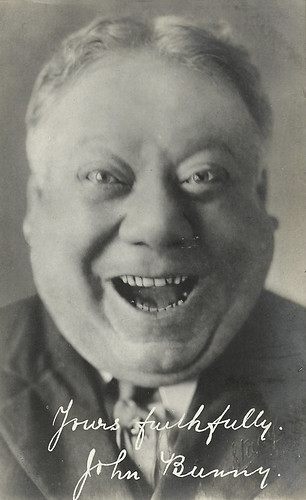
British or American postcard. Editor unknown. In contrast to most American film companies, who had London as their hub for the European film distribution market, Vitagraph had opened an office in Paris and arranged its European publicity from there, including the astonishing film posters (de)signed by Harry Bedos.
American actor and comedian John Bunny (1863-1915) was considered the first true comedy star of the early American silent film era. He acted in over a hundred short comedies at Vitagraph, often with Flora Finch. By 1909 he was already under contract to Vitagraph, and his character as a well-fed, carefree man quickly made him an international silent comedy star. Bunny's comedy was not slapstick, crass, and circus-inspired but polite, middle-class, situational comedy, often situated in domestic settings. He played Mr. Pickwick in The Pickwick Papers (Laurence Trimble, 1913), a three-reeler based on Charles Dicken's classic tale.

British postcard. Editor unknown. Caption: Flora Finch, of the Vitagraph Players.
Flora Finch (1867-1940) was an English-born vaudevillian, stage, and film actress who starred in over 300 silent films. She formed a popular pair with John Bunny in a series of more than a hundred Vitagraph comedies, commonly identified as the 'Bunnygraphs' or 'Bunnyfinches'. Several of the Bunny and Finch comedies have been found in the Desmet Collection of the Eye Filmmuseum (Netherlands) and can be found on Eye's YouTube section, such as Stenographer's Troubles, Bunny's Suicide, and Tangled Tangoists. A candid gossip: Finch disliked Bunny, who reportedly was arrogant, short-tempered, and generally difficult to work with.

French postcard, probably issued by Vitagraph's subsidiary in Paris, no. 3. Photo: Vitagraph. Caption: Maurice Costello, artist of The Vitagraph Co.
Maurice Costello (1877-1950) was a prominent American vaudeville actor of the late 1890s and early 1900s, who later became a prominent matinee idol and director at The Vitagraph Co. of America. He made fun of his own image in the delicious comedy The Picture Idol (James Young, 1912) with Clara Kimball Young as his idolising fan.
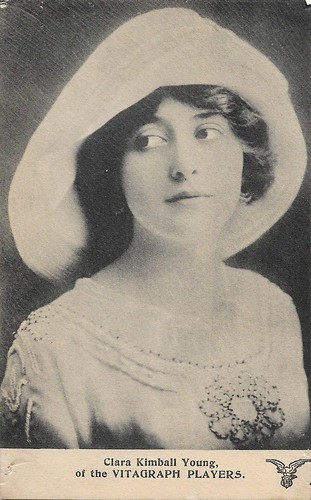
British postcard. Photo: Vitagraph. Caption: Clara Kimball Young of the Vitagraph Players.
American film actress Clara Kimball Young (1890-1960) was very popular in the early silent film era. After sending a photograph to Vitagraph Studios, Kimball Young was offered a yearly contract in 1912. Young's star at Vitagraph rose quickly. She was predominantly cast in melodramas and romantic comedies as the virtuous heroine. By 1913, she had become one of the more popular leading ladies at Vitagraph. Then, Vitagraph released the drama My Official Wife (James Young, 1914), which starred Young as a Russian revolutionary. The film, which is now lost, was an enormous success and launched Young into first place in the popularity polls.
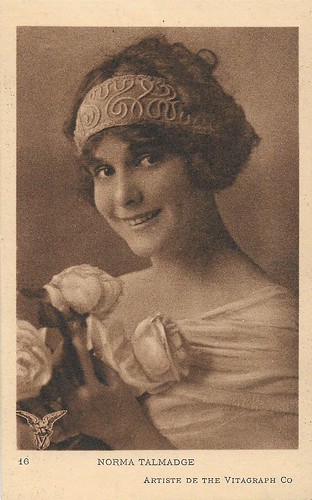
French postcard, no. 16. Photo: Vitagraph. Caption: Norma Talmadge, artist of The Vitagraph Co.
Between 1909 and 1915, Norma Talmadge (1894-1957) was one of the regular actors at Vitagraph, acting in hundreds of shorts, but also in the feature The Battlecry for Peace. She was a major box office draw for more than a decade. Her career reached a peak in the early 1920s when she ranked among the most popular idols on the American screen.
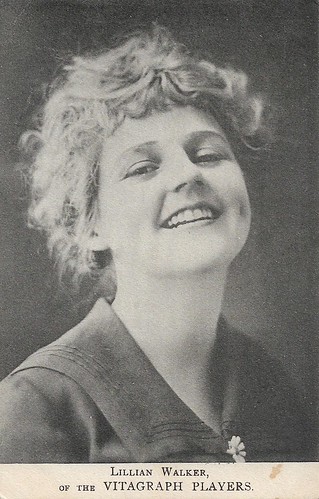
British postcard. Photo: Vitagraph. Caption: Lillian Walker of the Vitagraph Players.
American silent film actress Lillian Walker (1887-1975) appeared in 178 films between 1909 and 1934. In 1909 she could be seen in her first part in a Vitagraph film, C.Q.D.; or, Saved by Wireless; a True Story of the Wreck of the Republic. She did 18 shorts in 1911, both dramas and comedies. Nicknamed 'Dimples', she played in the comedies with John Bunny and Wally Van. 1912 was a top year at Vitagraph with some 43 short films, followed by 35 more films in 1913, 28 in 1914, and 23 in 1915. Memorable were films like Those Troublesome Tresses, Cinderella's Slippers, and Miss Tomboy.
American silent comedians by La Novela Semanal Cinematográfica
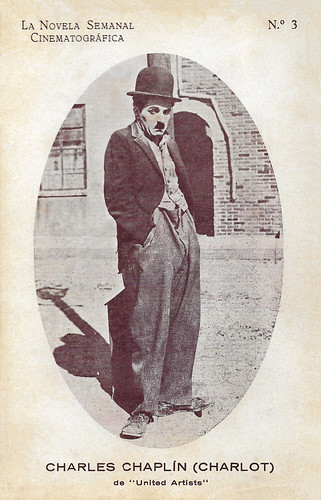
Spanish postcard by La Novela Semanal Cinematográfica, no. 3. Photo: United Artists (but the film was produced by First National). Charles Chaplin in A Dog's Life (Charles Chaplin, 1918). Charlot was the Spanish nickname for Chaplin.
English comedian Charles ‘Charlie’ Chaplin (1889-1977) was one of the most creative and influential personalities of the silent-film era. His most famous role was that of The Tramp with his toothbrush moustache, undersized bowler hat, and bamboo cane who struggled to survive while keeping his dignity in a world with great social injustice. Chaplin used mime, slapstick, and other visual comedy routines, and he not only starred in his films, but also directed, wrote, and produced them, and composed the music as well. His working life in entertainment spanned over 75 years, from the Victorian stage and the Music Hall in the United Kingdom as a child performer, until close to his death at the age of 88. Author George Bernard Shaw called Chaplin "the only genius to come out of the movie industry".
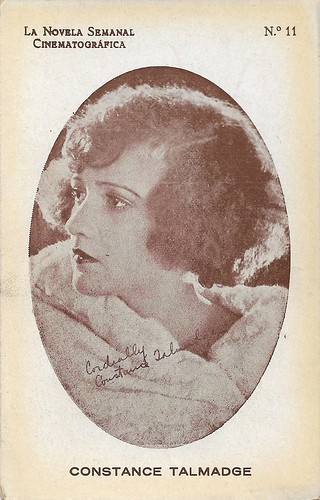
Spanish collectors card by La Novela Semanal Cinematográfica, no. 11.
Constance Talmadge (1898-1973) was an actress on the American silent screen, who started at Vitagraph in 1914. Talmadge had her breakthrough as the tomboyish Mountain Girl in D.W. Griffith's Intolerance (1916). Talmadge appeared in over 80 films, mostly comedies of manners, for which Anita Loos wrote several scripts, such as A Pair of Silk Stockings (1918), Happiness à la Mode (1919), Romance and Arabella (1919), Wedding Bells (1921), and The Primitive Lover (1922). Together with her sister Norma, Constance Talmadge was billed as one of the biggest stars of the twenties.
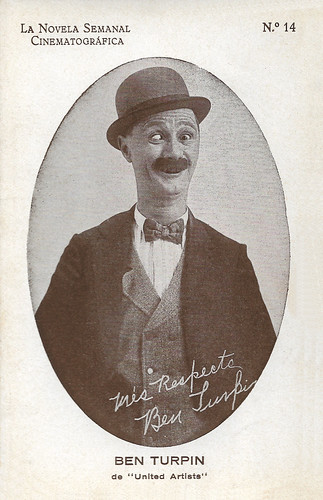
Spanish card by La Novela Semanal Cinematográfica, no. 14. Photo: United Artists.
Cross-eyed silent comedian Ben Turpin (1869-1940) was not born that way. Supposedly his right eye slipped out of alignment while playing the role of the similarly afflicted Happy Hooligan in vaudeville and it never adjusted. Ironically, it was this disability that would enhance his comic value and make him a top name in the silent film era. Turpin's true forte was impersonating the most dashingly romantic and sophisticated stars of the day and turning them into clumsy oafs. He also invented a Hollywood tradition by being the first actor to receive a pie in his face.

Spanish card by La Novela Semanal Cinematográfica, no. 84.
Wesley Barry (1907-1994) was an adorable child actor in silent comedies who was known for his face full of freckles. He later became a producer and director of both film and television. As a director, he was sometimes billed as Wesley E. Barry.
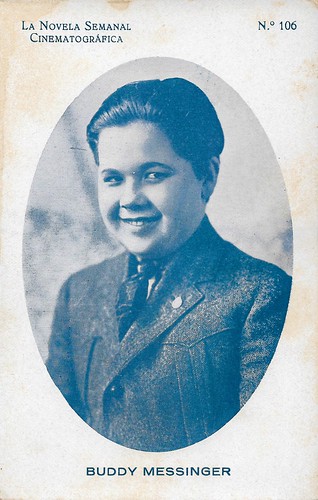
Spanish card by La Novela Semanal Cinematográfica, no. 106.
Buddy Messinger (1907–1965) was a popular child actor in American silent cinema of the late 1910s and 1920s. Between 1923 and 1925 he had his own series on the character of Buddy, produced by Century Film and distributed by Universal. In 1926-27 he worked for Bray Studios, and in 1928 he was in many episodes of the Drugstore Cowboy one-reel comedies. He continued in the sound era till the early 1940s - but in uncredited parts - while from the 1950s he worked as an assistant director.
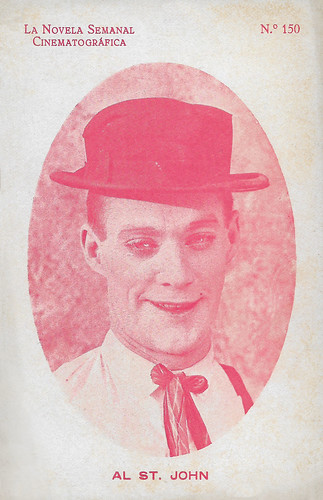
Spanish card by La Novela Semanal Cinematográfica, no. 150.
Al St. John (1892-1963) was an early American film comedian, and nephew of Roscoe 'Fatty' Arbuckle, with whom he often appeared. He appeared in dozens of Mack Sennett's early Keystone comedies and worked with Charlie Chaplin, Buster Keaton, and Mabel Normand. He would eventually create and star in his own vehicles for other studios. In the sound era, he was the sidekick of B-Western heroes like Bob Steele and Buster Crabbe. He played the scruffy comedy relief character 'Fuzzy Q. Jones' in the Billy the Kid series (1940-1946), and the Lone Rider series (1941-1943). From 1912 to 1952, Al St. John acted in 346 films.

Spanish postcard by La Novela Semanal Cinematográfica, no. 399.
American comedian Charles Murray (1872-1941) worked with George Sydney on a series of comedies around the Jewish Nate Cohen and the Irish Catholic Patrick Kelly, two business partners who are constantly fighting. Murray joined Biograph in 1912 (some sources say 1914). Two years later, he moved to Keystone, where he played the Hogan character. He appeared in several films opposite Charlie Chaplin and Mabel Normand. He remained a popular actor in 2-reel comedy shorts throughout the 1920s. Murray appeared in 283 films between 1912 and 1938, and also directed 5 films.
Spanish caricatures of American comedians by Martinez

Spanish collectors card by Chocolates Amatller, Barcelona, in the 'Artistas de cine' series, no. 11: Larry Semon. Image: Martinez Surroca. Fulgencio Martínez Surroca (1902-1967) was a Spanish cartoonist, illustrator and publicist.
Lawrence 'Larry' Semon (1889-1928) was an American actor, director, producer, and screenwriter during the silent film era. In his day, Semon was considered a major film comedian, but he is now remembered mainly for working with both Stan Laurel and Oliver Hardy before they started working together. He is also sometimes noted for directing (as well as appearing in) the silent film The Wizard of Oz (1925), which had a slight influence on the better-known sound version, The Wizard of Oz (1939).
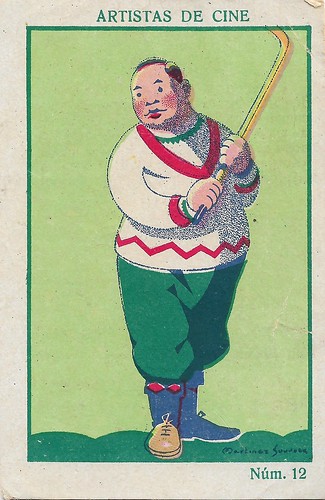
Spanish collectors card by Chocolates Amatller, Barcelona, in the 'Artistas de cine' series, no. 12: Walter Hiers. Image: Martinez Surroca.
Walter Hiers (1893-1933) was an American actor in silent cinema. During his two-decade-long acting career, spanning from 1912 to 1932, Hiers acted in over 100 films. He started out in 1912 in shorts by the Edison company, with William Wadsworth in the lead, while in 1913 -1914 he played at Lubin's, followed by a wide range of companies in subsequent years. In 1916 he did a whole string of shorts for Thanhouser.

Spanish collectors card by Chocolates Amatller, Barcelona, in the 'Artistas de cine' series, no. 14: Ben Turpin. Image: Martinez Surroca.

Spanish collectors card by Chocolates Amatller, Barcelona, in the 'Artistas de cine' series, no. 33: Bobby Vernon. Image: Martinez Surroca.
Bobby Vernon (1897-1939) was an American comedic actor in silent films. Blue-eyed with medium brown hair, he stood five feet and two-and-a-half inches, making him perfect for juvenile comedy roles. His comedies were popular with children. Mack Sennett teamed him up with young Gloria Swanson in nine comedies between 1916 and 1917, most memorably in Teddy at the Throttle (1917). He later became a writer and comedy supervisor at Paramount for W. C. Fields and Bing Crosby, when the sound era arrived.

Spanish collectors card by Chocolates Amatller, Barcelona, in the 'Artistas de cine' series, no. 37: Lloyd Hamilton. Image: Martinez Surroca.
Lloyd Hamilton (1891-1935) was an American film comedian. He is one of the numerous important comedians during the silent era whose popularity has turned into almost complete obscurity, Hamilton has nevertheless earned a reputation as an original talent. He teamed up with Bud Duncan in Kalem's 'Ham and Bud'-series, being one of the very first permanent comedy teams produced in the movies. The series turned out moderately popular and ran for three years. Hamilton left Kalem for Fox in late 1917 and starred in such comedies as Moonshine (1920) and The Simp (1920), and was hailed in the press as a "great comedy coup". He produced many fine short comedies throughout the decade, such as Move Along (1926), Nobody's Business (1926), and Somebody's Fault (1927), most of which were directed by Norman Taurog.
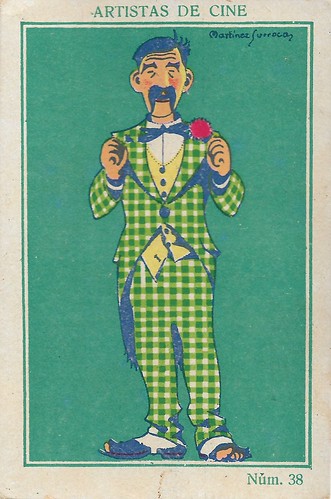
Spanish collectors card by Chocolates Amatller, Barcelona, in the 'Artistas de cine' series, no. 38: Snub Pollard. Image: Martinez Surroca.
Australian-born comedian Snub Pollard (1889-1962) with his walrus moustache was one of the well-known faces of the Hal Roach company during the 1910s. 'Snub' started off in bit parts at the Essanay Film Studios in 1911 and briefly worked with the Keystone Kops. Moving up into support roles, often with the Keystone Cops series, Hal Roach took an avid interest in him and, by 1915, had Snub co-starring with Harold Lloyd and Bebe Daniels in the highly successful Lonesome Luke series, which ran for years (86 films in all). In 1919, Snub took a chance and ventured on with his own solo one- and two-reelers with zany slapstick, sights gags, and gimmicks plenty.
Comedy stars we should never forget
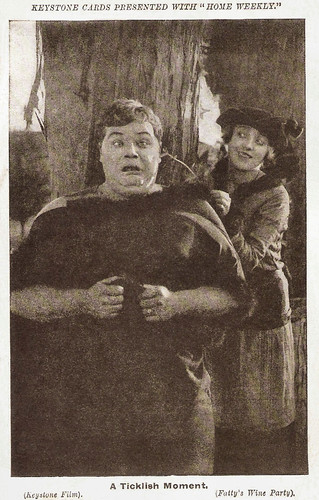
American postcard by Keystone cards, presented with Home Weekly. Photo: Keystone Film. Publicity still for Fatty's Wine Party (Roscoe 'Fatty' Arbuckle, 1914) with Fatty Arbuckle and Mabel Normand. Caption: A Ticklish Moment.
American silent film actor and comedian Roscoe ‘Fatty’ Arbuckle (1887-1933) was one of the most popular silent stars of the 1910s. He started at the Selig Polyscope and moved to Keystone Studios, where he worked with Mabel Normand and Harold Lloyd. Arbuckle mentored Charlie Chaplin and discovered Buster Keaton and Bob Hope. In 1920, he signed a contract with Paramount Pictures for US$1 million.

British postcard in the series "Keystone cards presented with Home Weekly". Photo: Keystone Film. Mabel Normand in The Sea Nymphs (Mack Sennett, 1914). Caption: Mabel as a sea nymph.
Mabel Normand (1892-1930) was a popular American silent film comedienne, in particular in her films with Charlie Chaplin. But alcohol, drugs, and scandal wrecked her career and TBC killed her at a young age.

British postcard in the series "Keystone cards presented with Home Weekly". Photo: Keystone Film. Chester Conklin and Minta Durfee in A Bird's A Bird (Walter Wright, 1915).
American comedian Chester Conklin (1886-1971) developed for Vaudeville his character patterned after his boss, a German baker named Schultz, with a thick accent and a very bushy walrus moustache. After seeing several of Mack Sennett's Keystone Kops shorts, Conklin applied for a job and stayed with Sennett for six years. Conklin became famous for his pairing with burly comic Mack Swain in a series of Ambrose and Walrus shorts. He also appeared in several of Charles Chaplin's shorts for the studio.
American comedienne Minta Durfee (1889-1975) began her career on stage in 1908 as a chorus girl in musical revues. She married comedian Roscoe 'Fatty' Arbuckle. In 1914, they entered Keystone and were soon a comedy double. Minta became Chaplin's leading lady in the two-reeler Making a Living (1914). In addition to the series of 'Fatty' featurettes, Minta also worked at Keystone in the classic madcap farce Tillie's Punctured Romance (1914) and co-starred opposite Chester Conklin, Mack Swain, and Ford Sterling in a series of outrageous daredevil comedies until 1916.

British postcard by Trans-Atlantic Film Co. Ltd. Photo: Nestor Film.
American actor, film director, and screenwriter Lee Moran (1888-1961) transcended the silent film era of motion pictures to the talkies. Moran was often paired with Eddie Lyons and the two made several silent comedies together. In 1912 Moran started at the Nestor company, first in the comedy Three of a Kind (1912), shot in New Mexico. Fall of 1912, Eddie Lyons joined their ranks, probably first in Hearts and Skirts (Al Christie, 1912), and soon became the leading man in Christie's films. Lyons and Moran were often paired as chums, at times also as antagonists in their films. Often the characters of Lyons and Moran were indicated by their first names, Lee and Eddie. Still, Moran also acted in many comedies by Christie without Lyons.
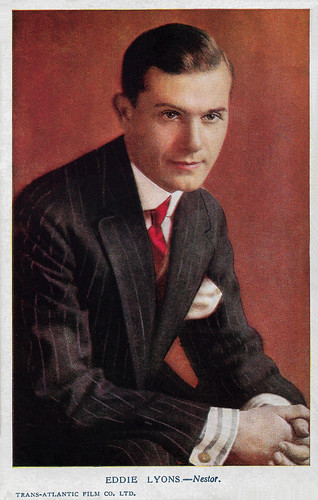
British postcard by Trans-Atlantic Film Co. Ltd. Photo: Nestor Film.
American film actor, director, writer, and producer Eddie Lyons (1886-1926) appeared in 388, directed 153, wrote for 93, and produced 40 films between 1911 and 1926. Debuting in minor parts at Biograph in 1911, Lyons moved in 1912 to IMP (Independent Motion Pictures of America), where he immediately got leads or major supporting parts in dramas and comedies, e.g. with Margarita Fischer. End of 1912 he shifted to Nestor Film. Just like his future film partner Lee Moran, Lyons was trained in vaudeville, hence their long-lasting partnership in acting together (from late 1912) at Nestor, and from 1916 also in directing and writing at Nestor and from 1918 at Universal, making hundreds of short comedies. The chums were immensely popular with American audiences. After his split with Moran in 1920/1921, Lyons continued with his own film company, Eddie Lyons Comedies (1921-1924). After that, Lyons' career slowed down and he had only a few minor parts in features in 1925 and 1926. In 1926 Eddie Lyons suddenly died of appendicitis in Pasadena, California.

American postcard. Photo: Universal Moving Pictures. On the back is an ink stamp by the Auditorium, Taunton, Mass.
Billie Ritchie (1878-1921) was a Scottish comedian who first gained transatlantic fame as a performer for British music hall producer Fred Karno — this was a full decade before Stan Laurel and Charlie Chaplin took a similar career path. Ritchie always claimed that Charlie Chaplin imitated his on-stage character of a rag-bedecked 'little tramp', although he himself was saddled with the description of being one of the many Chaplin imitators. Ritchie is best recalled today for the silent comedy shorts he made between 1914 and 1920 for director/producer Henry Lehrman's L-KO Kompany (distributed by Universal and its British distribution branch Transatlantic), and Fox Film Sunshine Comedy unit. While Lehrman directed Ritchie himself initially in 1914, afterwards other directors such as Harry Edwards and Al Christie took over. Regular co-actors were Eva Nelson and Gene Rogers. In 1917 Ritchie stepped over to Fox, where Lehrman, F. Richard Jones, William Campbell, and others directed him, while actresses such as Virginia Rappe and Betty Carpenter co-acted.
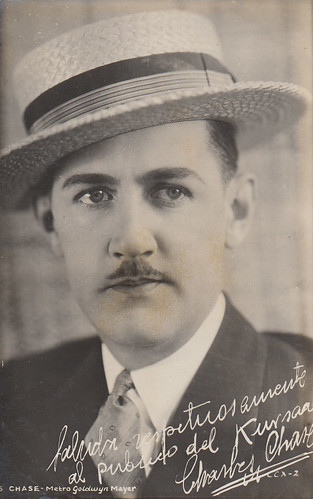
Spanish postcard by IFG. Photo: Metro Goldwyn Mayer. Collection: Marlene Pilaete.
American comedian, actor, screenwriter, and film director Charley Chase (1893-1940) was best known for his work in Hal Roach's short film comedies. Chase usually portrayed an apparently gentle and charming man who in reality, it eventually turned out, was quite a loser after all. While Chase is less famous than 'The Big Three' (Charles Chaplin, Buster Keaton, and Harold Lloyd), he's highly respected today by fans of silent comedy.
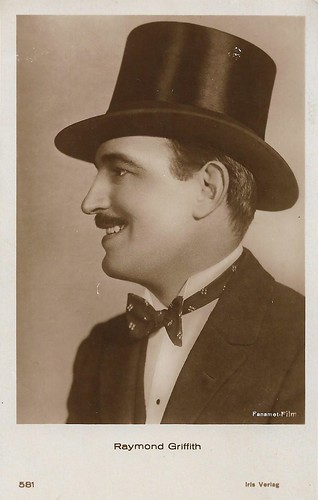
Austrian postcard by Iris Verlag, no. 581. Photo: Fanamet-Film.
Raymond Griffith (1895-1957) was an American comedian, known for such silent films as Paths to Paradise (1925) and Hands Up! (1926). In the sound era, he worked as a production supervisor and associate producer.
Five funny ladies

Spanish collectors card by Chocolate Amatller, Series KK, Artist 48, no. 94.
Marion Davies (1897-1961) was one of the great comedic actresses of the silent era. She starred in nearly four dozen films between 1917 and 1937. By 1924, Davies was the number one female box-office star in Hollywood because of the popularity of the historical dramas When Knighthood Was in Flower (1922) and Little Old New York (1923), which were among the biggest box-office hits of their respective years. However, she was at her best in contemporary comedies, especially three directed by King Vidor, The Patsy (1928), the backstage-in-Hollywood saga Show People (1928), and Not So Dumb (1930).

Italian postcard, no. 166. Photo: Bebe Daniels in Why Change Your Wife? (Cecil B. DeMille, 1920).
Bebe Daniels (1901-1971) was an American actress, singer, dancer, writer, and producer. She began her career in Hollywood during the silent film era as a child actress and later as the love interest of Harold Lloyd in dozens of short comedies. Cecil B. de Mille made her a silent star and later she sang and danced in early musicals like Rio Rita (1929) and 42nd Street (1933). In Great Britain, she gained further fame on stage, radio, and television. In her long career, Bebe Daniels appeared in 230 films.

French postcard by Editions Cinémagazine, no. 261. In France, Louise Fazenda was called Philomène.
Louise Fazenda (1895-1962) was a gawky, highly popular funny girl in slapstick comedies for Keystone Studios. She paired up well with comedian Charlie Murray. Her best-known character was her country bumpkin - complete with spit curls, multiple pigtails, and calico dresses. In the early 1920s, Louise left Sennett's company and progressed to feature films, where her eccentric talents were greatly utilised in musicals and knockabout comedies.
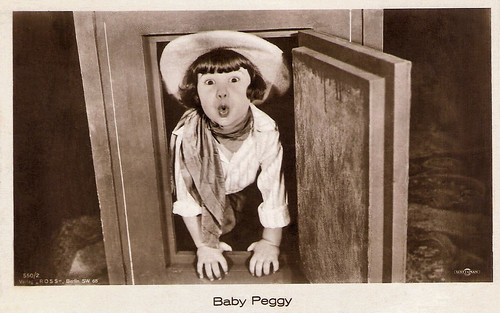
German postcard by Ross Verlag, Berlin, no. 550/2, 1919-1924. Photo: Unifilman.
Baby Peggy (1918-2020) was one of the three major American child stars of the Hollywood silent movie era along with Jackie Coogan and Baby Marie. The first film, Playmates in 1921, was a success, and Peggy was signed to a long-term contract with Century Studios. Between 1921 and 1923 she made over 150 short comedies for Century. In 1922 she received 1.2 million fan letters and by 1924 she had been dubbed 'The Million Dollar Baby' for her $1.5 million a year salary. Only a handful of Baby Peggy shorts, including Playmates (1921), Miles of Smiles (1923), and Sweetie (1923) have been discovered and preserved in film archives around the world.
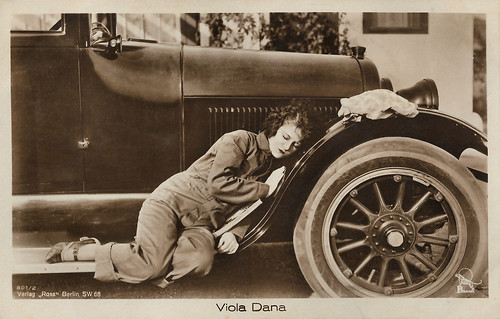
German postcard by Ross Verlag, Berlin, no. 801/2, 1925-1926. Photo: British-American Films AG (BAFAG).
American film actress Viola Dana (1897-1987) was successful during the silent era. She became a star with the Edison Company, working at their studio in the Bronx. Dana's success in Collins's Edison features such as Children of Eve (1915) and The Cossack Whip (1916) encouraged producer B. A. Rolfe to offer the couple lucrative contracts with his company, Rolfe Photoplays, which released their films through Metro Pictures Corporation. Vola starred for Rolfe/Metro in hits like The Girl Without a Soul (1917) and Blue Jeans (1917). Dana continued to act throughout the 1920s, but her popularity gradually waned. One of her last important roles was in Frank Capra's first film for Columbia Pictures, That Certain Thing (1928).
The Big Four
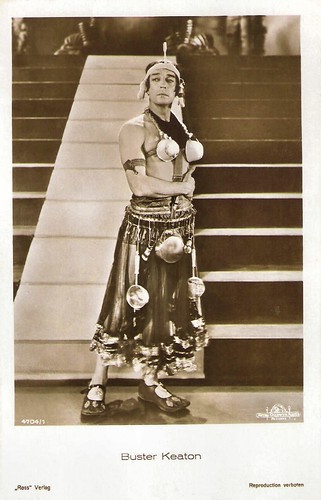
German postcard by Ross Verlag, no. 4704/1, 1929-1930. Photo: MGM. Buster Keaton as Princess Raja in The Hollywood Revue of 1929 (Charles Reisner, 1929). This performance must have been inspired by the Egyptian dance in The Cook (Roscoe 'Fatty' Arbuckle, 1918).
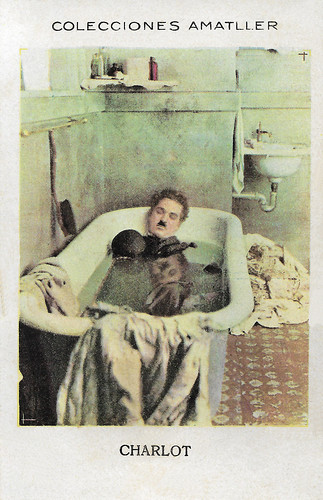
Spanish collectors card in the Collecciones Amatller Series, Serie D, artist no. 7, no. 26, by Chocolate Amatller. Photo: Charlie Chaplin in Pay Day (Charles Chaplin, 1922).
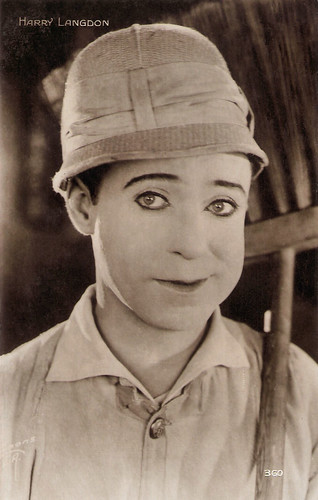
French postcard by Cinémagazine-Edition, Paris, no. 360. Photo: George Frederic Cannons, Los Angeles. Harry Langdon in Feet of Mud (Harry Edwards, 1924).
Hollywood comedian Harry Langdon (1884-1944), often called 'Baby Face', had enormous success during his heyday. Early in his film career, he had the good fortune to work regularly with director Harry Edwards, writer Frank Arthur Ripley, and the young Frank Capra. They created his unique character of the innocent and helpless man-child who found himself in dramatic and hazardous circumstances with only providence and good luck to survive. Despite his success, Langdon has remained far more obscure than his contemporaries as Charlie Chaplin, Buster Keaton, and Harold Lloyd.
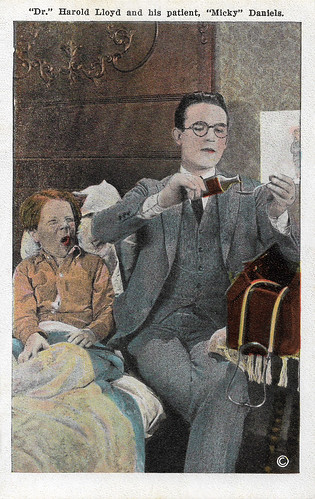
American postcard by Postcard Co. California, Los Angeles. Photo: Glen G. Stone, Los Angeles. Harold Lloyd and Mickey Daniels in Dr. Jack (1922). Captions: "Dr." Harold Lloyd and his patient, 'Mickey' Daniels. (front) Showing Harold Lloyd in the role of a doctor who "dispenses happiness". Both he and his patient "look their parts". For the freckled youngster, the happiness has evidently to come after the dose.
American actor, comedian, director, producer, screenwriter, and stunt performer Harold Lloyd (1893-1971) is best known for his silent comedies. He ranks alongside Charlie Chaplin and Buster Keaton as one of the three most popular and influential comedians of silent film. Between 1914 and 1947, Lloyd made nearly 200 comedies, often as a bespectacled 'Glass' character, a resourceful, success-seeking go-getter who was perfectly in tune with the 1920s-era United States. His films frequently contained 'thrill sequences' of extended chase scenes and daredevil physical feats. A classic is Lloyd hanging from the hands of a clock high above the street in Safety Last! (1923).
And finally, the most famous duo
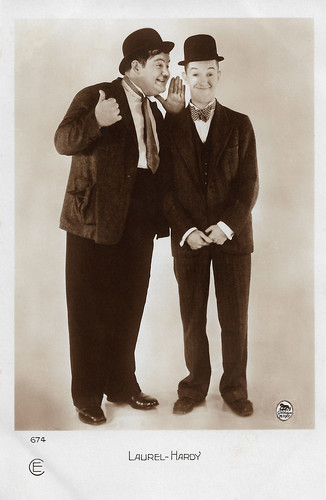
French postcard by Cinémagazine-Edition, Paris, no. 674. Photo: Goldwyn Mayer (MGM). Collection: Geoffrey Donaldson Institute.
Thin Englishman Stan Laurel (1890–1965) and heavyset American Oliver Hardy (1892–1957) were a comedy double act during the early Classical Hollywood era. They became well known during the late 1920s through the mid-1940s for their slapstick comedy with Laurel playing the clumsy and childlike friend of the pompous Hardy.
Sources: Wikipedia and IMDb.
No comments:
Post a Comment